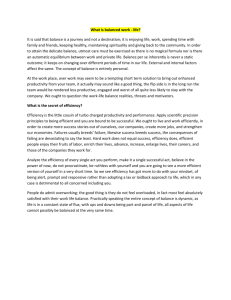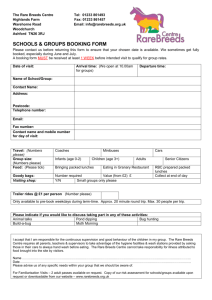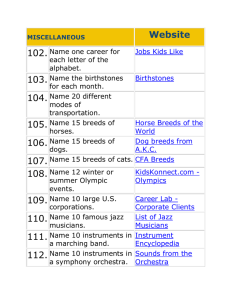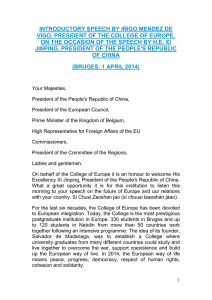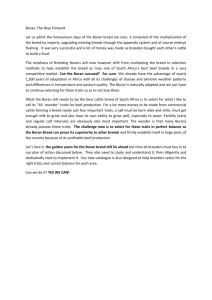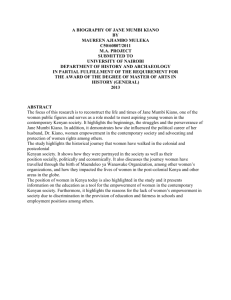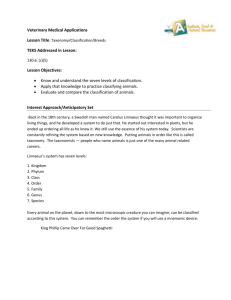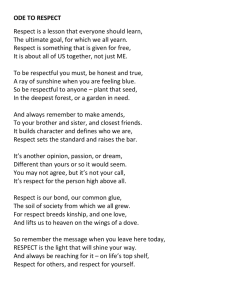4 Molecular characterisation of Kenyan zebu cattle
advertisement
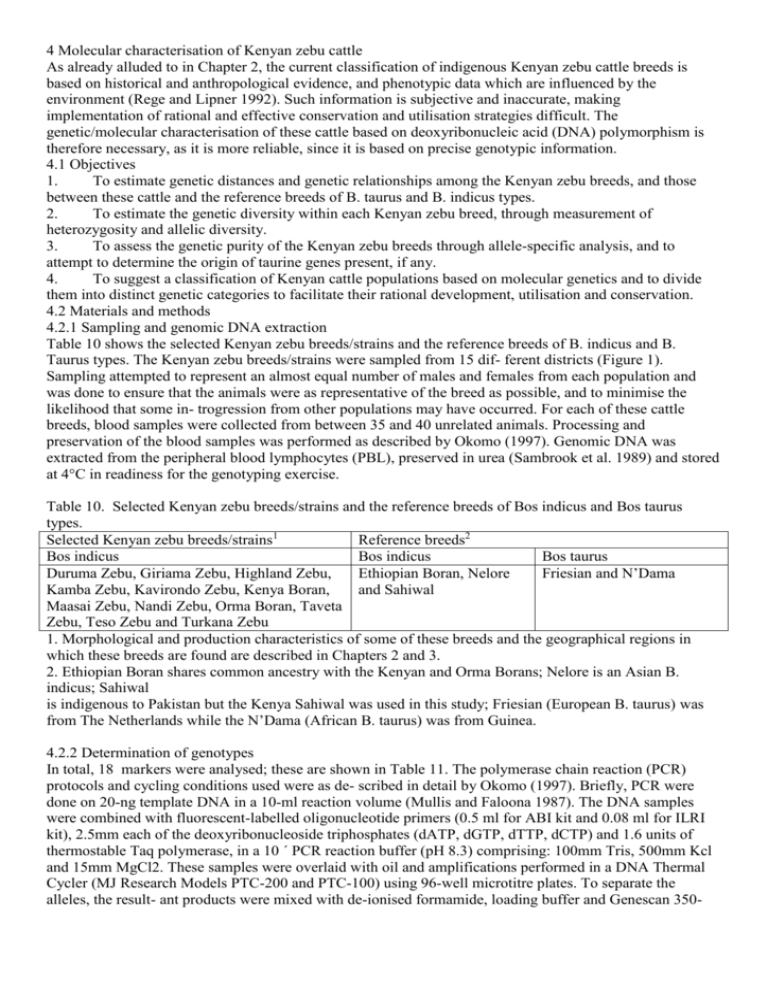
4 Molecular characterisation of Kenyan zebu cattle As already alluded to in Chapter 2, the current classification of indigenous Kenyan zebu cattle breeds is based on historical and anthropological evidence, and phenotypic data which are influenced by the environment (Rege and Lipner 1992). Such information is subjective and inaccurate, making implementation of rational and effective conservation and utilisation strategies difficult. The genetic/molecular characterisation of these cattle based on deoxyribonucleic acid (DNA) polymorphism is therefore necessary, as it is more reliable, since it is based on precise genotypic information. 4.1 Objectives 1. To estimate genetic distances and genetic relationships among the Kenyan zebu breeds, and those between these cattle and the reference breeds of B. taurus and B. indicus types. 2. To estimate the genetic diversity within each Kenyan zebu breed, through measurement of heterozygosity and allelic diversity. 3. To assess the genetic purity of the Kenyan zebu breeds through allele-specific analysis, and to attempt to determine the origin of taurine genes present, if any. 4. To suggest a classification of Kenyan cattle populations based on molecular genetics and to divide them into distinct genetic categories to facilitate their rational development, utilisation and conservation. 4.2 Materials and methods 4.2.1 Sampling and genomic DNA extraction Table 10 shows the selected Kenyan zebu breeds/strains and the reference breeds of B. indicus and B. Taurus types. The Kenyan zebu breeds/strains were sampled from 15 dif- ferent districts (Figure 1). Sampling attempted to represent an almost equal number of males and females from each population and was done to ensure that the animals were as representative of the breed as possible, and to minimise the likelihood that some in- trogression from other populations may have occurred. For each of these cattle breeds, blood samples were collected from between 35 and 40 unrelated animals. Processing and preservation of the blood samples was performed as described by Okomo (1997). Genomic DNA was extracted from the peripheral blood lymphocytes (PBL), preserved in urea (Sambrook et al. 1989) and stored at 4°C in readiness for the genotyping exercise. Table 10. Selected Kenyan zebu breeds/strains and the reference breeds of Bos indicus and Bos taurus types. Selected Kenyan zebu breeds/strains1 Reference breeds2 Bos indicus Bos indicus Bos taurus Duruma Zebu, Giriama Zebu, Highland Zebu, Ethiopian Boran, Nelore Friesian and N’Dama Kamba Zebu, Kavirondo Zebu, Kenya Boran, and Sahiwal Maasai Zebu, Nandi Zebu, Orma Boran, Taveta Zebu, Teso Zebu and Turkana Zebu 1. Morphological and production characteristics of some of these breeds and the geographical regions in which these breeds are found are described in Chapters 2 and 3. 2. Ethiopian Boran shares common ancestry with the Kenyan and Orma Borans; Nelore is an Asian B. indicus; Sahiwal is indigenous to Pakistan but the Kenya Sahiwal was used in this study; Friesian (European B. taurus) was from The Netherlands while the N’Dama (African B. taurus) was from Guinea. 4.2.2 Determination of genotypes In total, 18 markers were analysed; these are shown in Table 11. The polymerase chain reaction (PCR) protocols and cycling conditions used were as de- scribed in detail by Okomo (1997). Briefly, PCR were done on 20-ng template DNA in a 10-ml reaction volume (Mullis and Faloona 1987). The DNA samples were combined with fluorescent-labelled oligonucleotide primers (0.5 ml for ABI kit and 0.08 ml for ILRI kit), 2.5mm each of the deoxyribonucleoside triphosphates (dATP, dGTP, dTTP, dCTP) and 1.6 units of thermostable Taq polymerase, in a 10 ´ PCR reaction buffer (pH 8.3) comprising: 100mm Tris, 500mm Kcl and 15mm MgCl2. These samples were overlaid with oil and amplifications performed in a DNA Thermal Cycler (MJ Research Models PTC-200 and PTC-100) using 96-well microtitre plates. To separate the alleles, the result- ant products were mixed with de-ionised formamide, loading buffer and Genescan 350- TAMRA internal size standard, and electrophoresed for two hours through a 36 cm, 4.25% polyacrylamide denaturing gel on an ABI prismÔ 377 automated DNA se- quencer (Sambrook et al. 1989). Table 11. The analysed autosomal and Y-specific microsatellite loci. Autosomal loci ABI StockMarksTM ILRI/ILST kits AGLA293, TGLA48, TGLA53, ILST5, ILST6, ILST8, ILST13, TGLA122, TGLA126, TGLA227 ILST23, ILST28, ILST33, and MGTG4B ILST36, ILST50 and ILST103 Y-specific locus INRA124 4.2.3 Data analysis Analysis of data generated after gel electrophoresis was performed in a stepwise manner using different computer programs for different purposes as shown in Figure 7. To test for Hardy-Weinberg equilibrium (HWE; an indication of random breeding within a population), the null hypothesis of the test (H0) assumed random union of gametes. The P-value obtained for each locus-population combination ranged from zero to one (0.00–1.00). To test the null hypothesis a confidence limit of 99% was set, such that for P-values less than or equal to 0.01, the null hypothesis was rejected. Relative frequencies of 8 zebu-specific alleles (characteristic of B. indicus as represented by the Sahiwal and Nelore) at 8 autosomal microsatellite loci (TGLA126, TGLA48, TGLA53, ILST13, ILST28, ILST36, ILST50 and ILST103) and those of 10 taurine-specific alleles (characteristic of B. taurus as represented by the Friesian and N’Dama) at 8 autosomal microsatellite loci (AGLA293, TGLA48, TGLA122, ILST5, ILST13, ILST36, ILST50, and ILST103), were used to determine the proportion of indicine and taurine introgression, respectively, in the Kenyan zebu breeds. Similarly, allele frequency data generated from genotyping of the Y-specific microsatellite marker INRA124 were used to determine the percentages of taurine and indicine Y-chromosome alleles in each of the breeds studied. This marker consists of tandem repeat units of 2–5 base pairs each and is located at the DYS6 locus of the bovine male Y-chromosome (Vaiman et al. 1994). The Y-chromosome specific marker (INRA124) was typed using Principal Component analysis (PCA) and produced male- specific genotypings, with no apparent amplification observed in the female animals tested (controls). To complement the phylogenetic tree analysis (Figure 7), PCA, which is a multivariate technique for examining relationships among several quantitative vari- ables was performed. Carvalli-Sforza et al. (1994), using the SAS (SAS 1993), described the procedure of the performance. Principal components were computed using 213 variables (allele frequencies for a total of 213 different alleles observed at 17 microsatellite loci). Two sets of Principal Component analyses were carried out. The first analysis was performed on all 17 breeds of the study (i.e. the indigenous Kenyan breeds plus the reference breeds), while the se- cond analysis was performed on only the 12 indigenous Kenyan breeds. 4.3 Results 4.3.1 Tests of Hardy-Weinberg equilibrium The number of microsatellite loci showing deviations from Hardy-Weinberg equilibrium (HWE) in each of the populations is shown in Table 12. At a 99% confidence level, the number of loci deviating among the individual breeds ranged from 0 (out of 17) in the Friesian, Giriama Zebu and Highland Zebu to 7 (out of 17) in the Kenyan Boran. In the pooled sample, a total of 51 out of the maximum 289 deviated, which is a lot more than is expected by chance. Table 12. Number of microsatellite loci showing deviations from Hardy Weinberg equilibrium, average expected heterozygosity (and its standard error) and the total number of alleles observed across the autosomal microsatellite loci in each of the populations. Population/breed No. of Average expected Total no. of Average no. of microsatellite loci heterozygosity observed alleles observed alleles (P £ 0.01) (gene diversity) Duruma Zebu 3 0.707 (0.033) 118 6.9 Ethiopian Boran 4 0.718 (0.032) 123 7.2 Friesian 0 0.658 (0.034) 114 6.7 Giriama Zebu Highland Zebu Kamba Zebu Kavirondo Zebu Kenyan Boran Maasai Zebu Nandi Zebu N’Dama Nelore Orma Boran Sahiwal Taveta Zebu Teso Zebu Turkana Zebu Pooled sample (Total) 0 0 5 3 7 3 5 2 3 2 3 3 4 4 51 0.724 (0.037) 0.730 (0.030) 0.718 (0.027) 0.724 (0.029) 0.754 (0.022) 0.740 (0.025) 0.734 (0.029) 0.535 (0.050) 0.660 (0.052) 0.731 (0.027) 0.635 (0.048) 0.731 (0.028) 0.740 (0.023) 0.735 (0.028) 86 130 229 118 121 136 134 74 113 109 116 121 122 133 5.1 7.7 7 6.9 7.1 8 7.9 4.3 6.7 6.4 6.8 7.1 7.2 7.8 4.3.2 Heterozygosity Table 12 shows the average expected heterozygosities and their corresponding standard errors, as well as the total, and mean number of alleles observed across 17 autosomal microsatellite loci for each of the populations. The N’Dama had the lowest and the Kenya Boran the highest expected heterozygosity. Among the indigenous Kenyan zebu breeds, there were no significant differences between the average expected hetero- zygosities; however, when compared with the reference B. indicus and B. taurus breeds, the differences in the average heterozygosities were significant. No significant differences were observed in the total and average number of alleles recorded among the B. indicus (zebu) breeds, with the exception of the Giriama Zebu that recorded a significantly lower value of 86 alleles with a mean of only 5.1 alleles. Also estimated were the expected heterozygosities, level of gene differentiation among the breeds (Gst) and number of alleles per locus and across all loci. These are shown in Table 13. The ILST36 locus had the highest and the ILST33 the lowest expected hetero- zygosities. Gst ranged from 0.071 at the MGTG4B and TGLA53 loci, to 0.231 at the locus ILST33. The lowest number of alleles was at the TGLA48 and ILST33 loci. While the expected heterozygosities were directly proportional to the total number of alleles observed per locus, no significant or consistent correlations were observed between them and Gst values. Similarly, at most of the loci, no consistent correlations were observed between the number of alleles and Gst values. Table 13. Average expected heterozygosity (He), gene differentiation (Gst) and the number of alleles observed at the autosomal microsatellite loci. Locus Average expected Gene differentiation No. of alleles observed heterozygosity AGLA293 0.839 0.176 15 MGTG4B 0.874 0.071 12 TGLA122 0.865 0.067 20 TGLA126 0.800 0.079 8 TGLA227 0.872 0.209 16 TGLA48 0.719 0.200 5 TGLA53 0.785 0.071 19 ILST5 0.810 0.103 8 ILST6 0.815 0.088 11 ILST8 0.596 0.098 7 ILST13 0.696 0.125 12 ILST23 0.702 0.078 14 ILST28 0.796 0.074 14 ILST33 0.572 0.231 5 ILST36 ILST50 ILST103 Average Total 0.879 0.811 0.817 0.780 0.085 0.090 0.109 0.113 21 14 12 213 4.3.3 Evidence for genetic introgression from non zebu populations Table 14 shows the mean frequencies of taurine and zebu-specific alleles observed at eight autosomal microsatellite loci and of indicine and taurine haplotypes at the Y- chromosome-specific microsatellite locus in the Kenyan zebu cattle and the reference breeds. The N’Dama exhibited the highest (0.519) and the Nelore (0.060) the lowest mean frequency of the taurine alleles. Among the Kenyan zebu breeds, the Kenyan Boran had the highest (0.231) and the Duruma Zebu (0.068) the lowest mean frequency of taurine alleles. Mean frequencies of the zebu-specific alleles ranged from 0.031 in the N’Dama to 0.455 in the Sahiwal. Among the Kenyan zebu breeds, the Giriama Zebu had the highest proportion of zebu-specific alleles (0.424). Table 14. Mean frequencies of taurine and zebu-specific alleles observed at autosomal microsatellite loci and of indicine and taurine haplotypes at the Y-chromosome-specific microsatellite locus in the selected Kenyan zebu cattle and the reference breeds. Autosomal loci Y-chromosome-specific locus Population/breed Taurine alleles Zebu alleles No. of males tested Duruma Zebu Ethiopian Boran Friesian Giriama Zebu Highland Zebu Kamba Zebu Kapiti Boran Kavirondo Zebu Kenyan Boran Maasai Zebu Nandi Zebu N’Dama Nelore Orma Boran Sahiwal Taveta Zebu Teso Zebu Turkana Zebu 0.356 0.366 0.091 0.424 0.377 0.395 0.431 0.287 0.180 0.384 0.314 0.031 0.401 0.345 0.455 0.328 0.266 0.301 10 16 35 4 10 15 – 19 15 16 32 18 15 9 35 17 18 13 0.068 0.171 0.404 0.075 0.167 0.121 0.133 0.208 0.231 0.103 0.124 0.519 0.060 0.165 0.080 0.112 0.126 0.118 % indicine haplotype (130bp allele) 100 100 0 75 100 87 – 100 100 100 94 0 100 100 100 100 100 100 % aurine haplotype (132bp allele) 0 0 100 25 0 13 – 0 0 0 6 100 0 0 0 0 0 0 The results of the Y-chromosomal DNA analysis also gave an indication of extent of taurine introgression into the Kenyan zebu cattle populations. Two major genotypes were obtained in the male animals tested (Table 14). One genotype exhibited the 132- base pair (bp) allele, identified as the taurine allele, while the other was the 130-bp allele, identified as the indicine allele. Among the Kenyan zebu breeds, with the exception of the Giriama, Kamba and Nandi zebus, 100% of the males tested possessed the 130-bp zebu allele. As expected, 100% of the males of the reference breeds exhibited the haplo- type of their respective groups. 4.3.4 Genetic relationships among populations Table 15 shows the genetic distances (DS and DA) among the indigenous Kenyan zebu cattle and the reference breeds. The DS ranged from 0.008 in the Duruma Zebu vs. Giriama Zebu comparison to 1.127 in the N’Dama vs. Nelore comparison. Among the Kenyan zebu breeds, the DS values were generally low. The minimum DA value observed was between the Nandi Zebu and Turkana Zebu (0.059) followed by that between the Maasai Zebu and Nandi Zebu (0.064). The trend as pertains to which comparisons had the maximum DA values (generally among the indigenous Kenyan zebu breeds) was simi- lar to that observed for DS values. For example, as was the case with DS value, the highest recorded DA value was between the Giriama Zebu and the Kenyan Boran (0.357). Table 15. Standard genetic distances (DS) (below diagonal) and DA genetic distances (above diagonal) observed among the cattle populations.1 DRZ ETH FRS GRZ HLZ KMZ KVZ KYB MSZ NDA NDZ NEL ORB DRZ 0.191 0.453 0.133 0.18 0.104 0.223 0.27 0.114 0.442 0.106 0.28 0.236 ETH 0.224 0.358 0.282 0.066 0.179 0.074 0.142 0.166 0.378 0.149 0.183 0.076 FRS 0.855 0.7 0.489 0.332 0.412 0.311 0.31 0.395 0.306 0.355 0.422 0.351 GRZ 0.008 0.274 0.875 0.263 0.18 0.293 0.357 0.195 0.479 0.181 0.346 0.31 HLZ 0.191 0.046 0.638 0.235 0.168 0.084 0.137 0.156 0.374 0.143 0.152 0.1 KMZ 0.066 0.242 0.814 0.056 0.222 0.203 0.256 0.09 0.417 0.091 0.269 0.222 KVZ 0.267 0.064 0.53 0.303 0.069 0.28 0.104 0.179 0.354 0.157 0.194 0.09 KYB 0.416 0.164 0.522 0.532 0.182 0.418 0.089 0.218 0.36 0.202 0.22 0.151 MSZ 0.093 0.185 0.756 0.082 0.146 0.081 0.223 0.337 0.441 0.064 0.228 0.191 NDA 0.713 0.647 0.453 0.772 0.655 0.591 0.527 0.543 0.773 0.408 0.528 0.395 NDZ 0.065 0.166 0.664 0.068 0.133 0.082 0.178 0.277 0.015 0.685 0.245 0.177 NEL 0.467 0.217 0.928 0.507 0.187 0.506 0.288 0.367 0.344 1.127 0.398 0.176 ORB 0.265 0.054 0.665 0.297 0.97 0.293 0.088 0.175 0.231 0.699 0.218 0.247 SAH 0.354 0.133 0.855 0.36 0.151 0.422 0.191 0.359 0.263 1.102 0.285 0.161 0.198 TVZ 0.074 0.193 0.744 0.075 0.14 0.067 0.226 0.343 0.027 0.748 0.028 0.407 0.26 TSZ 0.119 0.259 0.676 0.13 0.224 0.098 0.238 0.297 0.069 0.548 0.039 0.445 0.27 TRZ 0.093 0.174 0.752 0.121 0.174 0.086 0.198 0.276 0.045 0.634 0.032 0.414 0.204 1. DRZ = Duruma Zebu; ETH = Ethiopian Boran; FRS = Friesian; GRZ = Giriama Zebu; HLZ = Highland Zebu; KMZ = Kamba Zebu; KVZ = Kavirondo Zebu; KYB = Kenyan Boran; MSZ = Maasai Zebu; NDA = N’Dama; NDZ = Nandi Zebu; NEL = Nelore; ORB = Orma Boran; SAH = Sahiwal; TVZ = Taveta Zebu; TSZ = Teso Zebu; TRZ = Turkana Zebu. The constructed phylogenetic tree revealed the existence of two distinct clusters, namely the Friesian– N’Dama cluster and one containing the rest of the breeds (Figure 8). This second cluster branches further into two distinct subclusters. The first subcluster contains the Sahiwal, Nelore, Kenyan Boran, Orma Boran, Ethiopian Boran, Highland Zebu and Kavirondo zebus. The second subcluster contains the rest of the indigenous Kenyan zebu breeds, and is divided further, with a very high bootstrap value of 90% into two groups, one containing the Taveta, Maasai, Nandi, Turkana and Teso zebus, and the other containing the Duruma, Giriama and Kamba zebus. Phylogenetic analysis carried out on only the 12 indigenous Kenyan zebu breeds, re- vealed two distinct clusters, with one containing the Kenyan Boran, Orma Boran, High- land Zebu and Kavirondo Zebu (Figure 9). The other cluster contains the rest of the breeds and is subdivided into two subclusters, one containing the Duruma, Giriama and Kamba zebus and the other, the Taveta, Maasai, Nandi, Turkana and Teso zebus. 4.3.5 Principal Component analysis The eigenvalues of the correlation matrix for the first three Principal Components, which accounted for about 63% of the total variation in both sets of analyses, are shown in Table 16. Also shown in this table, are the breeds separated by each set of Principal Component analysis. The genetic relationship among all the breeds is shown in Figure 10 while that among the 12 indigenous Kenyan breeds is shown in Figure 11. The main feature of Figure 10 is the clear separation of the Kenyan zebu breeds, from both the African and European taurines as well as from the Asian B. indicus breeds. The other important feature is the distinct clustering of the Kenyan breeds into two groups. The first (Group 1) contains the Kenyan Boran, Orma SAH 0.273 0.155 0.419 0.337 0.163 0.25 0.173 0.233 0.205 0.511 0.219 0.159 0.183 0.323 0.41 0.352 Boran and Ethiopian Boran, all orig- inating from the same ancestral stock, as well as the Highland Zebu and Kavirondo Zebu. The other cluster (Group 2) contains the rest of the Kenyan breeds studied. Table 16. The eigenvalues of the correlation matrix for the first three Principal Components (to which the percentage variance is proportional) and the breeds separated by each set of Principal Component analysis. No. of breeds 17 12 PC1 Eigenvalues 47.9 37.3 % of variance 30.3 23.5 Cumulative % of variance 30 53.8 1 2 3 1 15.8 37.6 10 39.7 63.8 39.7 2 12.4 13 52.7 3 9.9 10.4 63.1 Breeds separated by each set of PC analysis B. taurus and B. indicus Asian B. indicus and African B. indicus Kenyan B. indicus separated into two clusters European B. taurus and African taurine Kenyan B. indicus separated into two clusters Kenyan Boran, Duruma and Giriama Zebu and the rest of the Kenyan zebu breeds Highland Zebu and the rest of the Kenyan zebu breeds 1. PC = Principal Component. Figure 11 represents the results of an attempt to scrutinise further the distinct clustering of the Kenyan breeds into two groups and to resolve further the genetic relationships among the indigenous Kenyan breeds. 4.4 Discussion 4.4.1 Population structure and within-breed diversity The high within-breed variation based on the total and average number of alleles ob- served per breed and heterozygosities (Table 12) suggests that the populations were fairly outbred. Among the Kenyan zebu breeds, the Giriama Zebu had the lowest number of alleles observed. This was not surprising because compared with an average of 35 individ- uals sampled in the other populations, only seven Giriama Zebu individuals were sam- pled which may not be representative of the whole breed. The Kenyan Boran had the highest number of alleles (7 out of 17) that deviated from HWE, which can be attributed to artificial selection. As already alluded to, among the Kenyan zebu breeds, it is only the Kenyan Boran that has undergone improvement through cross-breeding with exotic B. taurus breeds (e.g. the Hereford) and artificial selection (Maule 1990). Artificial selection is the major genetic influence on modern domestic cattle populations (MacHugh et al. 1994). The slight deviation from HWE observed in the other Kenyan zebu cattle may be attributed to both recent and historic migrations of people with their cattle (leading to unquantified interbreeding with B. taurus and Sanga types) and to a lesser extent, selec- tion by the various tribes that rear the animals. 4.4.2 Extent of taurine introgression Results of the allele-specific and the Y-chromosomal DNA (Table 14) studies suggest that the Kenyan zebu cattle breeds studied have a mixture of both taurine and indicine genes. This indicates that the Kenyan zebu populations are not genetically pure B. indicus. The taurine alleles most probably result from recent crossbreeding with European breeds for improved production, as is the case with the Kenyan Boran, which exhibited the highest proportion of taurine alleles (23.1%). The presence of taurine alleles in the rest of the Kenyan zebu breeds may also be the result of historical cross-breeding with indigenous East African taurine and Sanga populations. However, the presence of taurine genes in some of these breeds (such as the Highland Zebu and the Nandi Zebu) may be due to recent increases in cross-breeding of indigenous breeds with B. taurus breeds (such as the Friesian and the Ayrshire) in an effort to boost milk production in the districts included in the study. The Y-chromosomal DNA analysis revealed the presence of male taurine genes in the Kamba Zebu (13%), Nandi Zebu (6%) and Giriama Zebu (25%) (Table 14). These results are inconsistent with those of the autosomal variation analysis and are a result of pre- dominantly male-mediated introgression of the taurine Y-chromosome (i.e. the taurine introgression is male-mediated). This is not surprising given the fact that there has been cross-breeding (either by natural mating or AI) of the indigenous cows with exotic bull. Males generally have a high reproductive rate as each male can be mated to several females and therefore can be used to disseminate superior genes. 4.4.3 Genetic diversity and relationships among breeds On the basis of standard genetic distance (DS) (Table 15), the closest genetic relationship among the studied Kenyan zebu populations was between the Duruma Zebu and the Giriama Zebu, while the most closely related breeds based on DA genetic distance were the Nandi Zebu and the Turkana Zebu. Geographically, the Duruma Zebu and the Giriama Zebu share very close proximity, as they inhabit neighbouring districts, Kwale and Kilifi, in the Coast Province, respectively. Some interbreeding may have occurred between the two populations to form a homogenous group. Explanation of the genetic similarity between the Nandi Zebu and the Turkana Zebu is not easy because the two populations are geographically distinct. However, incessant incidents of cattle rustling by tribes inhabiting the intermediate districts of West Pokot and Elgeyo Marakwet may have contributed to the migration and movement of cattle from the western to the northwestern regions of Kenya, and vice versa. Consequent interbreeding between such cattle may explain the genetic closeness of the Nandi Zebu to the Turkana Zebu. On the phylogenetic tree analysis, the groupings summarised on the UPGMA tree with standard genetic distances (DS), generally distinguished the humped (B. indicus) from the humpless (B. taurus) cattle. The Sahiwal and Nelore are separated from the Kenyan zebu breeds suggesting that the latter are not pure zebu, but possess a mixture of zebu and taurine backgrounds (Table 14). This tree also shows a clustering of the Kenyan zebu breeds into three groups: 1) Kenyan Boran, Orma Boran, Highland Zebu and Kavirondo Zebu (‘Boran group’); 2) Taveta Zebu, Maasai Zebu, Nandi Zebu, Turkana Zebu and Teso Zebu (‘Inland group’); and 3) Duruma Zebu, Giriama Zebu and Kamba Zebu (‘Coastal group’). Phylogenetic analy- sis (UPGMA method with DS) carried out on only the 12 indigenous Kenyan zebu breeds also supported the above results. The Ethiopian Boran showed very close genetic relationship to the Kenyan Boran and the Orma Boran. This was expected as all the above three populations are de- scended from the same ancestral stock (Chapter 2). The genetic closeness of the Kavirondo to the Kenyan Boran and the Orma Boran may be due to the fact that the Kavirondo Zebu possesses a significantly high mean frequency of taurine alleles that are also shared by the Kenyan Boran and the Orma Boran. The close genetic relationships seen in Group 2 are not easy to explain, as the majority of the breeds represented here are from geographically very distant and diverse environments, with the exception of the Nandi Zebu and the Teso Zebu that share a close geographical proximity. The close genetic relationship between the Duruma Zebu, Giriama Zebu and Kamba Zebu (Group 3) may also be explained by their close geographical proximity. The above results are generally consistent with the history and origins of indigenous zebu cattle (Chapter 2). The two different waves of zebu migration into Africa may explain the grouping of Kenyan zebu cattle into three clusters as seen in the phylogen- etic analysis. Groups 1 and 2 may principally have resulted from the genes arising from the first zebu influx through the Suez and across the Red Sea; whereas, Group 3 may have arisen from or been substantially influenced by the second influx, which came across the Indian Ocean and along the East African coast. Results of the Principal Component (PC) analysis carried out on all the 17 breeds (Table 16) were highly correlated with those of the phylogenetic tree analysis. PC analysis on the 12 indigenous Kenyan breeds showed a slight separation of the Kenyan Boran from the rest by the second PC. This may be because this population exhibits the highest proportion of taurine genes among all of the studied Kenyan zebu breeds. The Duruma and Giriama Zebus exhibited the lowest proportion of taurine genes, which may explain their slight separation by the second PC from the rest of the Kenyan zebu cattle that were analysed. The reason for the slight separation of the Highland Zebu from the other Kenyan zebu breeds by the third PC remains unclear, as there were no other significant findings in this population that might distinguish it from the rest of the populations analysed. This population inhabits a slightly higher altitude than the rest of the studied populations, but given the impact of exotic breeds on the Highland Zebu, these results were quite surprising. 4.5 Summary and conclusions The Kenyan zebu cattle populations were fairly outbred and apart from the Kenyan Boran, they were at HWE. This suggests that there has been little or no systematic selective breeding in these populations. Interbreeding and cross-breeding evident in these populations is mainly as a result of their close geographical proximity. The genetic distances, and phylogenetic and Principal Component analyses support the separate domestication and origin of the indigenous B. taurus and B. indicus cattle. The autosomal diagnostic allele analysis and Y-chromosomal DNA analysis indicated zebu predominance in Kenya. The Y-chromosomal DNA polymorphism detected provides a sensitive and quick assay for the detection of both recent and historical cross-breeding between taurine and indicine cattle populations. Y-chromosomal DNA analysis further proved that the taurine introgression detected in the Kenyan zebu cattle and taurine breeds is male-mediated. The Kenyan zebu is not a pure B. indicus, as evident by the taurine background that was detected in all the breeds, with the Kenyan Boran exhibiting the highest pro- portion of taurine influence. However, it was not determined whether the origin of the taurine influence in the Kenyan zebu breeds was from European or African B. taurus cattle. Kenyan zebu cattle appear to be a homogenous group of African cattle, distinct from the pure B. indicus and B. taurus, but more closely related to the former than the latter. The Kenyan zebu breeds can be classified into three genetically distinct groups: ‘Boran group’, ‘Coastal group’ and ‘Inland group’. The historic origin and the geo- graphic localisation of the breeds probably explain this separation. This study only analysed the genetic diversity of about one-third of the different Kenyan zebu cattle populations. The information obtained regarding the actual amount of genetic diversity in Kenyan zebu cattle breeds may be incomplete. Eighteen microsatellite markers (17 autosomal and one Y-specific) were used in this study. While this number might be considered sufficient to estimate the level of gene- tic variation between breeds, these markers were unable to clearly distinguish the origin of the taurine alleles observed as being from African or European B. taurus cattle. The use of more informative and diagnostic markers, that can distinguish between African and European taurine alleles, is therefore recommended.
